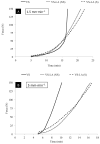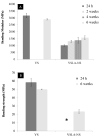Functional Properties of Low-Modulus PMMA Bone Cements Containing Linoleic Acid
- PMID: 33477310
- PMCID: PMC7839050
- DOI: 10.3390/jfb12010005
Functional Properties of Low-Modulus PMMA Bone Cements Containing Linoleic Acid
Abstract
Acrylic bone cements modified with linoleic acid are a promising low-modulus alternative to traditional high-modulus bone cements. However, several key properties remain unexplored, including the effect of autoclave sterilization and the potential use of low-modulus cements in other applications than vertebral augmentation. In this work, we evaluate the effect of sterilization on the structure and stability of linoleic acid, as well as in the handling properties, glass transition temperature, mechanical properties, and screw augmentation potential of low-modulus cement containing the fatty acid. Neither 1H NMR nor SFC-MS/MS analysis showed any detectable differences in autoclaved linoleic acid compared to fresh one. The peak polymerization temperature of the low-modulus cement was much lower (28-30 °C) than that of the high-modulus cement (67 °C), whereas the setting time remained comparable (20-25 min). The Tg of the low-modulus cement was lower (75-78 °C) than that of the high-stiffness cement (103 °C). It was shown that sterilization of linoleic acid by autoclaving did not significantly affect the functional properties of low-modulus PMMA bone cement, making the component suitable for sterile production. Ultimately, the low-modulus cement exhibited handling and mechanical properties that more closely match those of osteoporotic vertebral bone with a screw holding capacity of under 2000 N, making it a promising alternative for use in combination with orthopedic hardware in applications where high-stiffness augmentation materials can result in undesired effects.
Keywords: PMMA bone cement; bending; kyphoplasty; low-modulus; mechanical properties; screw pull-out; sterilization; vertebroplasty.
Conflict of interest statement
C.P. is co-owner of Inossia AB, which owns a patent on a low-modulus cement. Co-authors C.R., D.W., J.H., S.J.K.A.U., and C.Ö-M. have no conflicts of interest.
Figures





Similar articles
-
Mechanical characterization and cytocompatibility of linoleic acid modified bone cement for percutaneous cement discoplasty.J Mech Behav Biomed Mater. 2024 Oct;158:106662. doi: 10.1016/j.jmbbm.2024.106662. Epub 2024 Jul 21. J Mech Behav Biomed Mater. 2024. PMID: 39096682
-
In vivo response to a low-modulus PMMA bone cement in an ovine model.Acta Biomater. 2018 May;72:362-370. doi: 10.1016/j.actbio.2018.03.014. Epub 2018 Mar 17. Acta Biomater. 2018. PMID: 29559365
-
Long-term mechanical properties of a novel low-modulus bone cement for the treatment of osteoporotic vertebral compression fractures.J Mech Behav Biomed Mater. 2021 Jun;118:104437. doi: 10.1016/j.jmbbm.2021.104437. Epub 2021 Mar 4. J Mech Behav Biomed Mater. 2021. PMID: 33706086
-
NMP-modified PMMA bone cement with adapted mechanical and hardening properties for the use in cancellous bone augmentation.J Biomed Mater Res B Appl Biomater. 2009 Aug;90(2):760-6. doi: 10.1002/jbm.b.31345. J Biomed Mater Res B Appl Biomater. 2009. PMID: 19280644
-
Treatment options for vertebral fractures an overview of different philosophies and techniques for vertebral augmentation.Eur J Orthop Surg Traumatol. 2014 Jul;24 Suppl 1:S131-43. doi: 10.1007/s00590-013-1257-3. Epub 2013 Jun 16. Eur J Orthop Surg Traumatol. 2014. PMID: 23771597 Review.
Cited by
-
Different Modification Methods of Poly Methyl Methacrylate (PMMA) Bone Cement for Orthopedic Surgery Applications.Arch Bone Jt Surg. 2023;11(8):485-492. doi: 10.22038/ABJS.2023.71289.3330. Arch Bone Jt Surg. 2023. PMID: 37674694 Free PMC article. Review.
-
Quasi-static and dynamic mechanical properties of a linoleic acid-modified, low-modulus bone cement for spinal applications.Open Res Eur. 2024 May 21;3:203. doi: 10.12688/openreseurope.16683.2. eCollection 2023. Open Res Eur. 2024. PMID: 39185085 Free PMC article.
-
Low-Modulus PMMA Has the Potential to Reduce Stresses on Endplates after Cement Discoplasty.J Funct Biomater. 2022 Feb 4;13(1):18. doi: 10.3390/jfb13010018. J Funct Biomater. 2022. PMID: 35225981 Free PMC article.
-
Linoleic acid addition prevents Staphylococcus aureus biofilm formation on PMMA bone cement.Biofilm. 2025 Aug 7;10:100311. doi: 10.1016/j.bioflm.2025.100311. eCollection 2025 Dec. Biofilm. 2025. PMID: 40823343 Free PMC article.
-
Motion attenuation surgery in the degenerative lumbar spine: Is cement discoplasty a safe and effective option?Brain Spine. 2025 Mar 4;5:104220. doi: 10.1016/j.bas.2025.104220. eCollection 2025. Brain Spine. 2025. PMID: 40124635 Free PMC article.
References
-
- Haboush E.J. A new operation for arthroplasty of the hip based on biomechanics, photoelasticity, fast setting dental acrylic, and other considerations. Bull. Hosp. Jt. Dis. 1953;14:242–277. - PubMed
-
- Galibert P., Deramond H., Rosat P., Le Gars D. Deramond, Note préliminaire sur le traitement des angiomes vertébraux par vertébroplastie acrylique percutanée. Neurochirurgie. 1987;33:166–168. - PubMed
-
- Anselmetti G.C., Corrao G., della Monica P., Tartaglia V., Manca A., Eminefendic H., Russo F., Tosetti I., Regge D. Pain Relief Following Percutaneous Vertebroplasty: Results of a Series of 283 Consecutive Patients Treated in a Single. Cardiovasc. Intervent. Radiol. 2007;30:441–447. doi: 10.1007/s00270-006-0146-0. - DOI - PubMed
Grants and funding
LinkOut - more resources
Full Text Sources
Other Literature Sources
Miscellaneous

